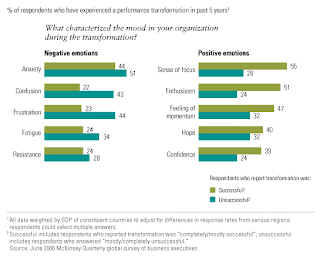A recent survey conducted by the McKinsey Quarterly (2006) among 1536 executives of publicly and privately held businesses across a full range of industries reveals the importance of emotions in the success of an organizational change. The respondents who experienced a performance transformation over the past 5 years were asked to rate it on a scale ranging from completely successful to completely unsuccessful. Those who rated their transformation as Completely / Mostly Successful and Completely / Mostly Unsuccessful were asked what characterized the mood in the organization during the transformation. The graphic shows the responses to that question for both successful and unsuccessful organizations.
McKinsey concludes that negative and positive moods are reported in roughly equal proportions, with anxiety as the most common emotion, ahead of confusion, frustration, fatigue and resistance. Among the positive moods, a sense of focus, enthusiasm, and feelings of momentum occur roughly equally. Finally more of the top performers report positive moods, especially focus and enthusiasm.
Two points of attention here:
- This research confirms that you will be confronted with emotions, regardles of whether the change is positive or negative.
- You can channel these emotions to the benefit of your change in order to obtain more clarity and less confusion.
Now the real question is: how do we channel these emotions so they can fuel your project instead of blocking it?


